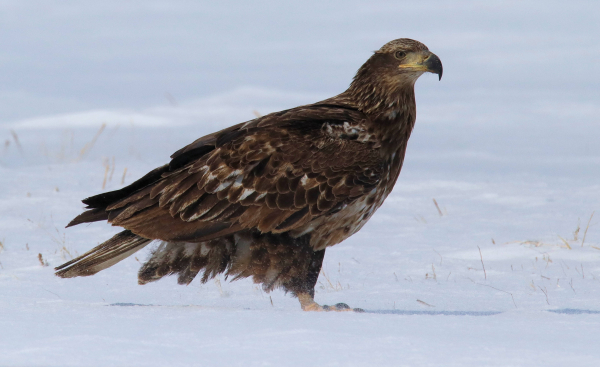
This is a second chapter in my Eagle Diary, which chronicles another photo series that brought great thrills just 4 days after the first diary episode shared with you here last week. It brought thrills while taking the photos and thrills when I reviewed the images on the big screen of my computer. But I must admit that for a few moments in between the thrills I felt a level of disappointment. This second diary chapter really had 3 parts: The first part took place outside my car window; the second part was especially thrilling in the field, but was at first disappointing as I reviewed the resulting photos – but there was a very happy ending.
The first part of the photo series was the chance to photograph a young Bald Eagle landing adjacent to my car. I actually used a series of 4 photos from that brief episode to illustrate my Editor Afield article last week. The eagle approached my position from behind on the driver’s side of the car, permitting me to focus on the large second-year eagle and begin photographing as it glided in my direction. To my surprise the eagle lowered its feet and landed – right outside my open window. I photographed the impressive eagle at close quarters as it raised a foot to warm it next to its body, while balancing on the other foot. I couldn’t have asked for a better photo opportunity of a young eagle standing in the snow, and after reviewing the series of photos of the eagle landing on my computer screen, those photos were especially rewarding – the end, Part 1.
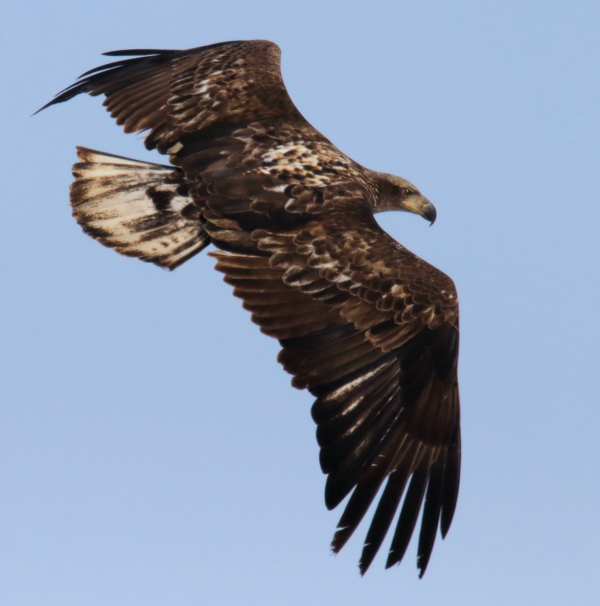
After flying straight away, the eagle banked to the side, showing its broad wings and tail coloration as it angled toward the south wind.
|
Part 2 began a half-minute or so later, when the impressive eagle took flight. Winging low straight away from me, it banked to the right to gain elevation, showing its back and the top of its wings and tail before it caught a gust of wind that propelled the eagle back in my direction. The next couple seconds of action made my jaw drop as they happened so quickly that all I could do was continue to take photos. As the eagle caught the stout south wind, it turned back toward me, filling my camera’s photo frame with more eagle than I could keep within the frame.
There wasn’t an opportunity to react and zoom my lens to open a larger frame, which could have included the full wingspan of the eagle. Instead, the action was happening so fast that all I could do was to concentrate on focusing the eagle’s face while intently holding the shutter release button down to take a series of images of the eagle’s dramatic flight. Whoosh, and eagle was out of sight, and I began breathing again. What a thrilling photo episode!
The Critical Review
That evening, as I reviewed photos of the young Bald Eagle, I was excited to see I had a nice series of images of the eagle landing; but the images after it took flight were quite disappointing – at first. As the eagle turned to gain elevation, I took a couple photos that included the full wingspan of the eagle, but as it banked into the wind, the eagle’s wings were immediately outside the photo frame, which provided what initially looked like a missed opportunity to photograph this dramatic flight action.
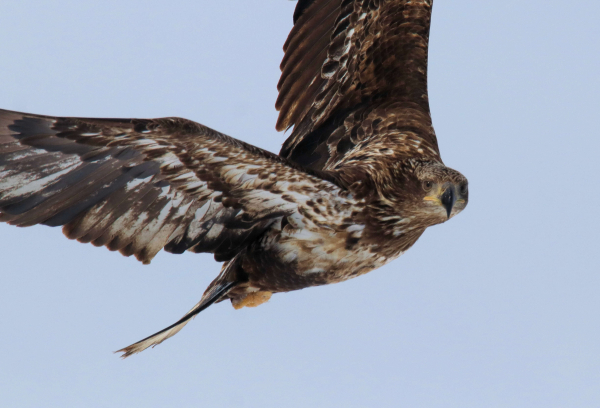
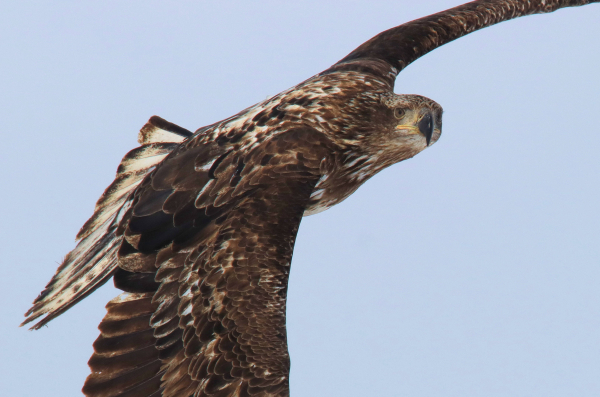
I went through all the images, took a quick break, then reviewed them again; and that’s when the light bulb went off and I realized the true quality of the images in which portions of the bird’s expansive wings were cropped outside the photo frame. Suddenly, my attention was focused on the eagle’s face, its head, its plumage without regard for the cropped portions of the wings. That’s when I appreciated how I could see the changing positions of the body, wings, and tail in consecutive photos, which provided a different way of seeing the value of these photos.
Each image was interesting on its own, but together they revealed so much more; and there was an artistic quality to these photos that I did not see at first. At first glance, I saw how I missed getting the whole eagle in the photo frame, and how much that compromised the photo. But frankly, those photos would have been all wings, with little detail of the eagle’s face and body motions during the extreme banking movements. The resulting photos provided exciting closer looks at the details of the eagle’s features as it moved that would have been lost without zeroing in on the bird’s head and all that surrounded it.
Now, granted, I didn’t have a chance to make any changes to the photo frame with the action happening so fast and the eagle flying so close in a split second. But having the images that I took, I had to rewire my initial impressions of the photos – the failed opportunity – and fully appreciate the qualities that were inherent in the images I managed under extreme circumstances. That said, I really like the resulting photo series and I’m sharing them with you to consider and reconsider too.
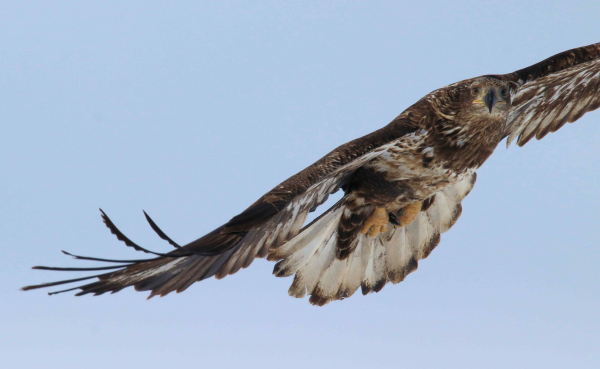
Camera Settings
Luckily, all the technical settings were dialed in. I always preset my camera for the current conditions, and although I had a moment’s chance to double check my settings when the eagle landed, the tech settings were fine. All the photos were taken with the same camera settings, using the aperture priority (Av) on the mode dial, which provides a corresponding shutter speed to the aperture (f-stop).
With a clear afternoon sky, bright sunlight with some light reflection off the snow cover, I used an f-10 aperture rather than my usual f-8, which provided a broader area in focus. That turned out to be an excellent decision, as all parts of the eagle were fully in focus. And the sharp images were also a product of the resulting ultra-fast 1/4000 shutter speed, which of course means the photograph was taken at a 4,000th of a second! As stated above, using the aperture priority setting, when I selected the f-10 aperture, the camera provided the corresponding shutter speed based on the ambient light level.
Under sunny conditions, I find that using an ISO setting of 400 provides a middle of the road light level, and although with the bright light available that day I could have used an ISO 200, or even ISO 100 setting, I try not to change the ISO levels unless there is reduced lighting when I turn the ISO up to 800.
Every bit as important as all the technical settings, I was also positioned so the eagle would be illuminated with the best natural sunlight, with the sun at my back and a bit to the right. But there was some true luck involved in the positioning of the eagle relative to the direction of the sunlight. The eagle was in perfect sunlight as it was standing on the snow near my car, but when it took flight, it was the eagle’s choice to fly back in the direction that provided optimum illumination under the moment’s circumstances. The fact that no hints of shadows show in the photos is testimony to the good lighting direction – What Luck!
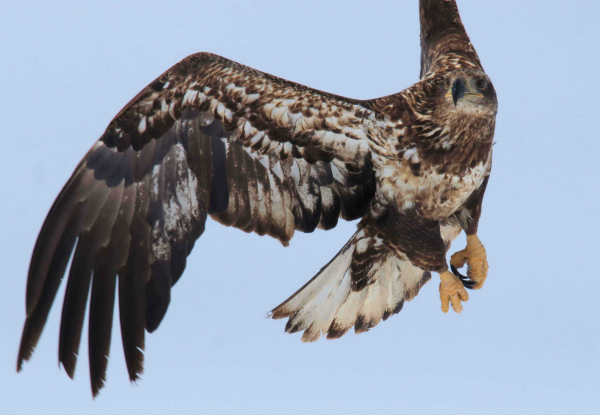
When the split-second action took place as the eagle banked into the wind, I was ready to take a high-speed series of photographs at up to 7 frames per second! All I had to do was to hold the shutter button down continuously and the shutter fired to record the series of photos that resulted – oh what fun! I always have my Drive Mode set for continuous shooting, and my camera takes a maximum of 7 photos per second, although some cameras take more photos per second, and some models take fewer images per second.
Although I rarely take continuous photos, I often like to take 2 images at a time. But I’m always ready to take a flurry of photos in super-fast succession when the occasion calls for it – usually as a bird is flying in dramatic fashion, like in the case of this impressive young Bald Eagle in flight above a remote snow-covered landscape.
Roadside Attraction
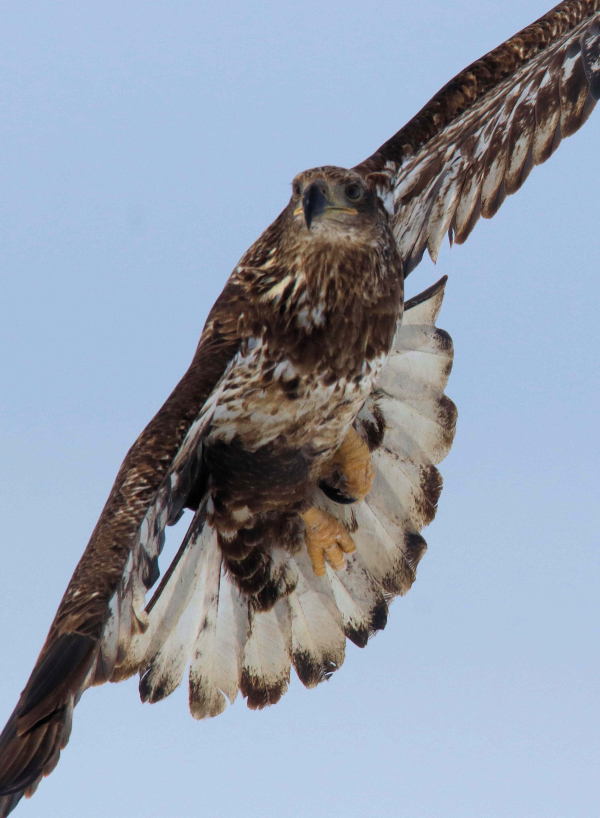
With the tail spread as wide as possible, its braking action is in full force as the eagle’s widespread wings use the wind to propel it back in a circular flight. All the action happened in a flash, documented in a special photo series.
|
A couple moments after the young eagle swept by me, I first came to the remember that this eagle and an adult had minutes before erupted into flight before me as I drove over a hilltop. They were feeding on a roadkill, and now I realized I was parked a few yards away from that important food source. In my rearview mirror I saw the young eagle land on a rise a short distance behind my car, and although I was still reeling from the excitement of photographing the fast action in rapid succession, I realized the eagle was intent on returning to feed, sidetracked for some moments by anything I was doing.
Always trying to keep the birds’ well-being in mind, I did not stop next to the food source intentionally, but rather as a reaction to the eagles taking flight before me. But now I knew I needed to move on down the road with the hope the eagles would return to feed. About a half-mile away, I stopped on the next hilltop to check on the scene behind me. The young Bald Eagle was already back to feeding, obviously hungry during its push northward into the Dakota snow zone.
That’s when I found myself momentarily consumed by the dramatic scene before me – a favorite landscape of rugged rolling hills, now pristine white as it was covered in feet of bright snow. Pondering that perhaps the adult eagle would return, I also imagined that perhaps the sub-adult eagle was prospering by being able to feed unchallenged for a time. At that point I left the remote hilltop to continue my birding drive and bid the eagle well for the meeting.
So far there isn’t a story to share as Eagle Diary III, but you never know … Considering these 2 productive photo episodes transpired just 4 days apart, it’s very special for me to share the background stories as well as the photography elements that made them so successful. For this diary chapter, I guess the best takeaway might be to take a second look at some photos – a single photo or a series of photos – and maybe put on some rose-colored glasses that will help you to see another angle to the pros and cons of just how good a given image or series of photos is. I hope you can appreciate the process I went through with these photos and hope you enjoy the results, as different as they may be. Spring is providing new bird photography opportunities almost daily it seems, so I hope you have been successful wherever your birding activities transpire.
Article and photographs by Paul Konrad
Share your bird photos and birding experiences at editorstbw2@gmail.com